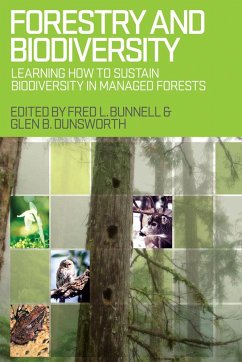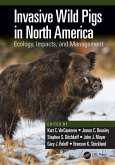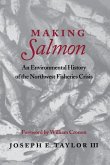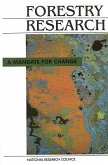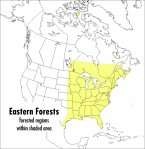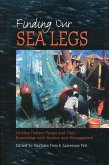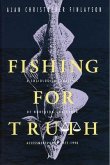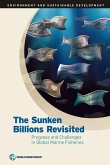Forestry and Biodiversity
Learning How to Sustain Biodiversity in Managed Forests
Herausgeber: Bunnell, Fred L
Schade – dieser Artikel ist leider ausverkauft. Sobald wir wissen, ob und wann der Artikel wieder verfügbar ist, informieren wir Sie an dieser Stelle.
Forestry and Biodiversity
Learning How to Sustain Biodiversity in Managed Forests
Herausgeber: Bunnell, Fred L
- Broschiertes Buch
- Merkliste
- Auf die Merkliste
- Bewerten Bewerten
- Teilen
- Produkt teilen
- Produkterinnerung
- Produkterinnerung
This book is about the politics of lawsuits in which multiple parties are pitted against powerful corporate interests in a battle for money, pride, and prominence. Yet, at the heart of these struggles is the tension between what it means to be an individual and a member of a group, between law and policy. It is a compelling read with great legal stories and a strong analytic structure.--John Brigham, University of Massachusetts, Amherst-
Andere Kunden interessierten sich auch für
![Invasive Wild Pigs in North America Invasive Wild Pigs in North America]() Invasive Wild Pigs in North America86,99 €
Invasive Wild Pigs in North America86,99 €![Making Salmon Making Salmon]() Joseph E TaylorMaking Salmon35,99 €
Joseph E TaylorMaking Salmon35,99 €![Forestry Research Forestry Research]() National Research CouncilForestry Research45,99 €
National Research CouncilForestry Research45,99 €![A Peterson Field Guide to Eastern Forests A Peterson Field Guide to Eastern Forests]() John KricherA Peterson Field Guide to Eastern Forests23,99 €
John KricherA Peterson Field Guide to Eastern Forests23,99 €![Finding Our Sea Legs Finding Our Sea Legs]() Finding Our Sea Legs24,99 €
Finding Our Sea Legs24,99 €![Fishing for Truth Fishing for Truth]() Alan Christopher FinlaysonFishing for Truth24,99 €
Alan Christopher FinlaysonFishing for Truth24,99 €![Sunken Billions Revisited Sunken Billions Revisited]() World BankSunken Billions Revisited41,99 €
World BankSunken Billions Revisited41,99 €
This book is about the politics of lawsuits in which multiple parties are pitted against powerful corporate interests in a battle for money, pride, and prominence. Yet, at the heart of these struggles is the tension between what it means to be an individual and a member of a group, between law and policy. It is a compelling read with great legal stories and a strong analytic structure.--John Brigham, University of Massachusetts, Amherst-
Produktdetails
- Produktdetails
- Verlag: University of British Columbia Press
- Seitenzahl: 374
- Erscheinungstermin: 1. Januar 2010
- Englisch
- Abmessung: 228mm x 153mm x 28mm
- Gewicht: 555g
- ISBN-13: 9780774815307
- ISBN-10: 0774815302
- Artikelnr.: 28252196
- Herstellerkennzeichnung
- Libri GmbH
- Europaallee 1
- 36244 Bad Hersfeld
- gpsr@libri.de
- Verlag: University of British Columbia Press
- Seitenzahl: 374
- Erscheinungstermin: 1. Januar 2010
- Englisch
- Abmessung: 228mm x 153mm x 28mm
- Gewicht: 555g
- ISBN-13: 9780774815307
- ISBN-10: 0774815302
- Artikelnr.: 28252196
- Herstellerkennzeichnung
- Libri GmbH
- Europaallee 1
- 36244 Bad Hersfeld
- gpsr@libri.de
Fred L. Bunnell is a professor emeritus of forestry and conservation biology at the University of British Columbia. Glen B. Dunsworth is a forest ecology and conservation biology consultant.
List of Illustrations
Preface
Acknowledgments
Part 1: Introduction
1 The Problem / Fred L. Bunnell, Glen B. Dunsworth, David J. Huggard, and
Laurie L. Kremsater
1.1 "Wicked" Problems
1.2 Expanding and Competing Values
1.3 Special Difficulties in Forests
1.4 Adaptive Management
1.5 Bounding the Book: What It Is and Is Not
1.6 Summary
2 The Example / Fred L. Bunnell, William J. Beese, and Glen B. Dunsworth
2.1 Physical and Ecological Setting
2.1.1 Physical Landscape
2.1.2 Climate, Vegetation, and Fauna
2.2 Social and Historical Contexts
2.3 New Planning and Practices
2.3.1 Planning
2.3.2 Practices
2.4 Structures to Make It Work
2.5 Monitoring
2.6 Summary
3 The Approach / Fred L. Bunnell and Glen B. Dunsworth
3.1 Managers' Questions
3.2 Establishing Objectives and Measures of Success
3.2.1 Defining Biological Diversity
3.2.2 A Criterion and Indicators of Success
3.3 Deciding on Actions
3.4 Evaluating Success
3.4.1 Bounding the Problem
3.4.2 The Major Questions
3.4.3 Kinds of Monitoring and Adaptive Management
3.4.4 Creating Structured Learning
3.5 Linking Findings to Actions
3.6 Summary
4 Implementing the Approach / Fred L. Bunnell, William J. Beese, and Glen
B. Dunsworth
4.1 Change in Midstream
4.2 Progress in Adopting the Approach
4.2.1 Implementing Planning
4.2.2 Implementing Variable Retention
4.3 Assessing the Outcomes of Guidelines
4.3.1 Biological Legacies
4.3.2 Forest Influence
4.3.3 Amount of Retention
4.3.4 Forest Stewardship
4.3.5 Requisite Variety
4.4 Lessons from Implementation Monitoring
4.5 Summary
Part 2: The Indicators
5 Effectiveness Monitoring: An Introduction / Fred L. Bunnell, David J.
Huggard, and Glen B. Dunsworth
5.1 Context
5.2 How Do We Ask Our Questions?
5.3 What Would We Do with the Data if We Had Them?
5.4 How Do We Discern What Is Better?
5.5 Where Does the Answer Apply?
5.6 The Role of Pilot Studies
5.7 Summary
6 Ecosystem Representation: Sustaining Poorly Known Species and Functions /
David J. Huggard and Laurie L. Kremsater
6.1 Rationale
6.2 What to Monitor
6.2.1 Amount of Non-Harvestable or Lightly Managed Area
6.2.2 Ecosystem Representation
6.2.3 Size of Non-Harvestable Patches and Geographic Distribution
6.2.4 Edge and Interior
6.2.5 Special Ecosystems and Productivity
6.2.6 Other Indices of Spatial Pattern
6.2.7 Natural Disturbances and Stand Age Distribution
6.2.8 Responsibility and Regional Protected Areas
6.3 How to Monitor
6.4 Anticipated Feedback to Management
6.5 Summary
7 Learning from Ecosystem Representation / David J. Huggard, Laurie L.
Kremsater, and Glen B. Dunsworth
7.1 Context
7.2 Methods
7.2.1 Ecosystem Representation
7.2.2 Edge/Interior and Patch Size
7.2.3 Other Land Use Designations Emphasizing Conservation
7.2.4 Responsibility and Protected Areas
7.3 Results
7.3.1 Responsibility and Protected Areas
7.3.2 Representation of Variants in the Non-Harvestable Land Base
7.3.3 Representation of Site Series
7.3.4 Edge/Interior and Other Spatial Aspects
7.3.5 Representation in Other Conservation Designations
7.4 Discussion
7.4.1 Limitations of Analysis
7.4.2 Management Priorities: Under-Represented Dry Variants
7.4.3 Management Priorities: Edge Effects
7.4.4 Focusing Finer-Filter Monitoring
7.5 Summary
8 Sustaining Forested Habitat / David J. Huggard, Fred L. Bunnell, and
Laurie L. Kremsater
8.1 Rationale
8.1.1 Habitat Elements in Stands
8.l.2 Habitat Structure in Stands
8.1.3 Landscape Features
8.2 What to Monitor
8.2.1 Standard Habitat Elements and Their Attributes
8.2.2 Integrative Habitat Variables
8.2.3 Process Variables for Long-Term Habitat Projections
8.2.4 Landscape Features
8.2.5 Hypothetical Species as Landscape Indices
8.3 How to Monitor
8.3.1 Standard Habitat Elements and Their Attributes
8.3.2 Integrative Habitat Variables (Habitat Structures)
8.3.3 Process Variables for Long-Term Habitat Projections
8.3.4 Landscape Features
8.3.5 Hypothetical Species for Landscape Evaluation
8.4 Anticipated Feedback to Management
8.5 Summary
9 Learning from Habitat Elements / David J. Huggard, Jeff Sandford, and
Laurie L. Kremsater
9.1 Context
9.2 Methods
9.2.1 Field Methods
9.2.2 Subsampling Design
9.2.3 Study Design
9.2.4 Approach to Summaries
9.3 Results and Implications
9.3.1 Expected Precision
9.3.2 Comparison among Retention Types
9.3.3 Comparison of Retention Patches with Uncut Benchmarks
9.3.4 Relationships of Habitat Elements with Percent Retention
9.3.5 Edge Effects
9.3.6 Comparison of Patch Anchor Types
9.3.7 Operational Progress
9.4 General Discussion
9.5 Summary
10 Sustaining Forest-Dwelling Species / Laurie L. Kremsater and Fred L.
Bunnell
10.1 Rationale
10.2 What to Monitor? An Overview
10.3 What to Monitor: Vascular Plants
10.3.1 Factors Influencing Monitoring: Vascular Plants
10.3.2 How to Monitor: Vascular Plants
10.3.3 Links to Management: Vascular Plants
10.4 What to Monitor: Bryophytes
10.4.1 Factors Influencing Monitoring: Bryophytes
10.4.2 How to Monitor: Bryophytes
10.4.3 Links to Management: Bryophytes
10.5 What to Monitor: Lichens
10.5.1 Factors Influencing Monitoring: Lichens
10.5.2 How to Monitor: Lichens
10.5.3 Links to Management: Lichens
10.6 What to Monitor: Fungi
10.6.1 Factors Influencing Monitoring: Fungi
10.6.2 How to Monitor: Fungi
10.6.3 Links to Management: Fungi
10.7 What to Monitor: Invertebrates
10.7.1 Factors Influencing Monitoring: Invertebrates
10.7.2 How to Monitor: Invertebrates
10.7.3 Links to Management: Invertebrates
10.8 What to Monitor: Vertebrates
10.8.1 Factors Influencing Monitoring: Vertebrates
10.8.2 What to Monitor: Vertebrates
10.8.3 Links to Management: Vertebrates
10.9 Overall Feedback to Management
10.10 Summary
11 Learning from Organisms / David J. Huggard and Laurie L. Kremsater
11.1 Context
11.2 Intended Roles of the Pilot Study Phase
11.2.1 Assess Sensitivity to Forest Practices
11.2.2 Define Ecological Strata
11.2.3 Define Appropriate Sampling Methods
11.2.4 Guide Optimization of Sampling
11.2.5 Illustrate Ways to Generalize
11.2.6 Summary of the Pilot Phase
11.3 Individual Monitoring Projects
11.3.1 Breeding Bird Surveys
11.3.2 Songbirds
11.3.3 Owls
11.3.4 Red Squirrels
11.3.5 Carabid (Ground) Beetles
11.3.6 Gastropods
11.3.7 Bryophytes and Vascular Plants
11.3.8 Epiphytic Lichens
11.3.9 Ectomycorrhizal Fungi
11.3.10 Aquatic-Breeding Amphibians
11.4 Summary
Part 3: Summary
12 Designing a Monitoring Program / David J. Huggard, Laurie L. Kremsater,
and Fred L. Bunnell
12.1 Context
12.2 How to Ask Questions
12.2.1 Comparisons and Mechanisms
12.2.2 Types of Comparisons
12.3 Stand-Level Comparisons
12.3.1 Very High-Priority Comparisons
12.3.2 High-Priority Comparisons
12.3.3 Moderate-Priority Comparisons
12.3.4 Low-Priority Comparisons
12.3.5 Summary of Comparisons
12.4 Selecting Indicator Variables
12.5 Matching Indicators with Comparisons
12.6 Answering Questions Well
12.6.1 Operational versus Experimental Comparisons
12.6.2 Blocking Factors
12.6.3 Pre-Treatment Measurement
12.7 Monitoring over Larger Areas
12.7.1 Indicator 1: Representation of Ecosystem Types in Non-Harvestable
Areas
12.7.2 Indicator 2: Stand and Landscape Features
12.7.3 Indicator 3: Organisms
12.7.4 Other Possible Ecological Variables for Broad-Scale Monitoring
12.8 The Role of Models
12.8.1 General Modelling Approach
12.8.2 Specific Forms of Modelling
12.8.3 Implications of Incorporating Mechanisms
12.9 Summary
13 Summary: Progress and Lessons Learned / Fred L. Bunnell, David J.
Huggard, and Laurie L. Kremsater
13.1 Context
13.2 Progress
13.3 Lessons Learned
13.3.1 Organizational Structure
13.3.2 Design
13.3.3 Feedback
13.4 Summary Thoughts
Appendices
Notes
Glossary
Literature Cited
List of Contributors
Index
Preface
Acknowledgments
Part 1: Introduction
1 The Problem / Fred L. Bunnell, Glen B. Dunsworth, David J. Huggard, and
Laurie L. Kremsater
1.1 "Wicked" Problems
1.2 Expanding and Competing Values
1.3 Special Difficulties in Forests
1.4 Adaptive Management
1.5 Bounding the Book: What It Is and Is Not
1.6 Summary
2 The Example / Fred L. Bunnell, William J. Beese, and Glen B. Dunsworth
2.1 Physical and Ecological Setting
2.1.1 Physical Landscape
2.1.2 Climate, Vegetation, and Fauna
2.2 Social and Historical Contexts
2.3 New Planning and Practices
2.3.1 Planning
2.3.2 Practices
2.4 Structures to Make It Work
2.5 Monitoring
2.6 Summary
3 The Approach / Fred L. Bunnell and Glen B. Dunsworth
3.1 Managers' Questions
3.2 Establishing Objectives and Measures of Success
3.2.1 Defining Biological Diversity
3.2.2 A Criterion and Indicators of Success
3.3 Deciding on Actions
3.4 Evaluating Success
3.4.1 Bounding the Problem
3.4.2 The Major Questions
3.4.3 Kinds of Monitoring and Adaptive Management
3.4.4 Creating Structured Learning
3.5 Linking Findings to Actions
3.6 Summary
4 Implementing the Approach / Fred L. Bunnell, William J. Beese, and Glen
B. Dunsworth
4.1 Change in Midstream
4.2 Progress in Adopting the Approach
4.2.1 Implementing Planning
4.2.2 Implementing Variable Retention
4.3 Assessing the Outcomes of Guidelines
4.3.1 Biological Legacies
4.3.2 Forest Influence
4.3.3 Amount of Retention
4.3.4 Forest Stewardship
4.3.5 Requisite Variety
4.4 Lessons from Implementation Monitoring
4.5 Summary
Part 2: The Indicators
5 Effectiveness Monitoring: An Introduction / Fred L. Bunnell, David J.
Huggard, and Glen B. Dunsworth
5.1 Context
5.2 How Do We Ask Our Questions?
5.3 What Would We Do with the Data if We Had Them?
5.4 How Do We Discern What Is Better?
5.5 Where Does the Answer Apply?
5.6 The Role of Pilot Studies
5.7 Summary
6 Ecosystem Representation: Sustaining Poorly Known Species and Functions /
David J. Huggard and Laurie L. Kremsater
6.1 Rationale
6.2 What to Monitor
6.2.1 Amount of Non-Harvestable or Lightly Managed Area
6.2.2 Ecosystem Representation
6.2.3 Size of Non-Harvestable Patches and Geographic Distribution
6.2.4 Edge and Interior
6.2.5 Special Ecosystems and Productivity
6.2.6 Other Indices of Spatial Pattern
6.2.7 Natural Disturbances and Stand Age Distribution
6.2.8 Responsibility and Regional Protected Areas
6.3 How to Monitor
6.4 Anticipated Feedback to Management
6.5 Summary
7 Learning from Ecosystem Representation / David J. Huggard, Laurie L.
Kremsater, and Glen B. Dunsworth
7.1 Context
7.2 Methods
7.2.1 Ecosystem Representation
7.2.2 Edge/Interior and Patch Size
7.2.3 Other Land Use Designations Emphasizing Conservation
7.2.4 Responsibility and Protected Areas
7.3 Results
7.3.1 Responsibility and Protected Areas
7.3.2 Representation of Variants in the Non-Harvestable Land Base
7.3.3 Representation of Site Series
7.3.4 Edge/Interior and Other Spatial Aspects
7.3.5 Representation in Other Conservation Designations
7.4 Discussion
7.4.1 Limitations of Analysis
7.4.2 Management Priorities: Under-Represented Dry Variants
7.4.3 Management Priorities: Edge Effects
7.4.4 Focusing Finer-Filter Monitoring
7.5 Summary
8 Sustaining Forested Habitat / David J. Huggard, Fred L. Bunnell, and
Laurie L. Kremsater
8.1 Rationale
8.1.1 Habitat Elements in Stands
8.l.2 Habitat Structure in Stands
8.1.3 Landscape Features
8.2 What to Monitor
8.2.1 Standard Habitat Elements and Their Attributes
8.2.2 Integrative Habitat Variables
8.2.3 Process Variables for Long-Term Habitat Projections
8.2.4 Landscape Features
8.2.5 Hypothetical Species as Landscape Indices
8.3 How to Monitor
8.3.1 Standard Habitat Elements and Their Attributes
8.3.2 Integrative Habitat Variables (Habitat Structures)
8.3.3 Process Variables for Long-Term Habitat Projections
8.3.4 Landscape Features
8.3.5 Hypothetical Species for Landscape Evaluation
8.4 Anticipated Feedback to Management
8.5 Summary
9 Learning from Habitat Elements / David J. Huggard, Jeff Sandford, and
Laurie L. Kremsater
9.1 Context
9.2 Methods
9.2.1 Field Methods
9.2.2 Subsampling Design
9.2.3 Study Design
9.2.4 Approach to Summaries
9.3 Results and Implications
9.3.1 Expected Precision
9.3.2 Comparison among Retention Types
9.3.3 Comparison of Retention Patches with Uncut Benchmarks
9.3.4 Relationships of Habitat Elements with Percent Retention
9.3.5 Edge Effects
9.3.6 Comparison of Patch Anchor Types
9.3.7 Operational Progress
9.4 General Discussion
9.5 Summary
10 Sustaining Forest-Dwelling Species / Laurie L. Kremsater and Fred L.
Bunnell
10.1 Rationale
10.2 What to Monitor? An Overview
10.3 What to Monitor: Vascular Plants
10.3.1 Factors Influencing Monitoring: Vascular Plants
10.3.2 How to Monitor: Vascular Plants
10.3.3 Links to Management: Vascular Plants
10.4 What to Monitor: Bryophytes
10.4.1 Factors Influencing Monitoring: Bryophytes
10.4.2 How to Monitor: Bryophytes
10.4.3 Links to Management: Bryophytes
10.5 What to Monitor: Lichens
10.5.1 Factors Influencing Monitoring: Lichens
10.5.2 How to Monitor: Lichens
10.5.3 Links to Management: Lichens
10.6 What to Monitor: Fungi
10.6.1 Factors Influencing Monitoring: Fungi
10.6.2 How to Monitor: Fungi
10.6.3 Links to Management: Fungi
10.7 What to Monitor: Invertebrates
10.7.1 Factors Influencing Monitoring: Invertebrates
10.7.2 How to Monitor: Invertebrates
10.7.3 Links to Management: Invertebrates
10.8 What to Monitor: Vertebrates
10.8.1 Factors Influencing Monitoring: Vertebrates
10.8.2 What to Monitor: Vertebrates
10.8.3 Links to Management: Vertebrates
10.9 Overall Feedback to Management
10.10 Summary
11 Learning from Organisms / David J. Huggard and Laurie L. Kremsater
11.1 Context
11.2 Intended Roles of the Pilot Study Phase
11.2.1 Assess Sensitivity to Forest Practices
11.2.2 Define Ecological Strata
11.2.3 Define Appropriate Sampling Methods
11.2.4 Guide Optimization of Sampling
11.2.5 Illustrate Ways to Generalize
11.2.6 Summary of the Pilot Phase
11.3 Individual Monitoring Projects
11.3.1 Breeding Bird Surveys
11.3.2 Songbirds
11.3.3 Owls
11.3.4 Red Squirrels
11.3.5 Carabid (Ground) Beetles
11.3.6 Gastropods
11.3.7 Bryophytes and Vascular Plants
11.3.8 Epiphytic Lichens
11.3.9 Ectomycorrhizal Fungi
11.3.10 Aquatic-Breeding Amphibians
11.4 Summary
Part 3: Summary
12 Designing a Monitoring Program / David J. Huggard, Laurie L. Kremsater,
and Fred L. Bunnell
12.1 Context
12.2 How to Ask Questions
12.2.1 Comparisons and Mechanisms
12.2.2 Types of Comparisons
12.3 Stand-Level Comparisons
12.3.1 Very High-Priority Comparisons
12.3.2 High-Priority Comparisons
12.3.3 Moderate-Priority Comparisons
12.3.4 Low-Priority Comparisons
12.3.5 Summary of Comparisons
12.4 Selecting Indicator Variables
12.5 Matching Indicators with Comparisons
12.6 Answering Questions Well
12.6.1 Operational versus Experimental Comparisons
12.6.2 Blocking Factors
12.6.3 Pre-Treatment Measurement
12.7 Monitoring over Larger Areas
12.7.1 Indicator 1: Representation of Ecosystem Types in Non-Harvestable
Areas
12.7.2 Indicator 2: Stand and Landscape Features
12.7.3 Indicator 3: Organisms
12.7.4 Other Possible Ecological Variables for Broad-Scale Monitoring
12.8 The Role of Models
12.8.1 General Modelling Approach
12.8.2 Specific Forms of Modelling
12.8.3 Implications of Incorporating Mechanisms
12.9 Summary
13 Summary: Progress and Lessons Learned / Fred L. Bunnell, David J.
Huggard, and Laurie L. Kremsater
13.1 Context
13.2 Progress
13.3 Lessons Learned
13.3.1 Organizational Structure
13.3.2 Design
13.3.3 Feedback
13.4 Summary Thoughts
Appendices
Notes
Glossary
Literature Cited
List of Contributors
Index
List of Illustrations
Preface
Acknowledgments
Part 1: Introduction
1 The Problem / Fred L. Bunnell, Glen B. Dunsworth, David J. Huggard, and
Laurie L. Kremsater
1.1 "Wicked" Problems
1.2 Expanding and Competing Values
1.3 Special Difficulties in Forests
1.4 Adaptive Management
1.5 Bounding the Book: What It Is and Is Not
1.6 Summary
2 The Example / Fred L. Bunnell, William J. Beese, and Glen B. Dunsworth
2.1 Physical and Ecological Setting
2.1.1 Physical Landscape
2.1.2 Climate, Vegetation, and Fauna
2.2 Social and Historical Contexts
2.3 New Planning and Practices
2.3.1 Planning
2.3.2 Practices
2.4 Structures to Make It Work
2.5 Monitoring
2.6 Summary
3 The Approach / Fred L. Bunnell and Glen B. Dunsworth
3.1 Managers' Questions
3.2 Establishing Objectives and Measures of Success
3.2.1 Defining Biological Diversity
3.2.2 A Criterion and Indicators of Success
3.3 Deciding on Actions
3.4 Evaluating Success
3.4.1 Bounding the Problem
3.4.2 The Major Questions
3.4.3 Kinds of Monitoring and Adaptive Management
3.4.4 Creating Structured Learning
3.5 Linking Findings to Actions
3.6 Summary
4 Implementing the Approach / Fred L. Bunnell, William J. Beese, and Glen
B. Dunsworth
4.1 Change in Midstream
4.2 Progress in Adopting the Approach
4.2.1 Implementing Planning
4.2.2 Implementing Variable Retention
4.3 Assessing the Outcomes of Guidelines
4.3.1 Biological Legacies
4.3.2 Forest Influence
4.3.3 Amount of Retention
4.3.4 Forest Stewardship
4.3.5 Requisite Variety
4.4 Lessons from Implementation Monitoring
4.5 Summary
Part 2: The Indicators
5 Effectiveness Monitoring: An Introduction / Fred L. Bunnell, David J.
Huggard, and Glen B. Dunsworth
5.1 Context
5.2 How Do We Ask Our Questions?
5.3 What Would We Do with the Data if We Had Them?
5.4 How Do We Discern What Is Better?
5.5 Where Does the Answer Apply?
5.6 The Role of Pilot Studies
5.7 Summary
6 Ecosystem Representation: Sustaining Poorly Known Species and Functions /
David J. Huggard and Laurie L. Kremsater
6.1 Rationale
6.2 What to Monitor
6.2.1 Amount of Non-Harvestable or Lightly Managed Area
6.2.2 Ecosystem Representation
6.2.3 Size of Non-Harvestable Patches and Geographic Distribution
6.2.4 Edge and Interior
6.2.5 Special Ecosystems and Productivity
6.2.6 Other Indices of Spatial Pattern
6.2.7 Natural Disturbances and Stand Age Distribution
6.2.8 Responsibility and Regional Protected Areas
6.3 How to Monitor
6.4 Anticipated Feedback to Management
6.5 Summary
7 Learning from Ecosystem Representation / David J. Huggard, Laurie L.
Kremsater, and Glen B. Dunsworth
7.1 Context
7.2 Methods
7.2.1 Ecosystem Representation
7.2.2 Edge/Interior and Patch Size
7.2.3 Other Land Use Designations Emphasizing Conservation
7.2.4 Responsibility and Protected Areas
7.3 Results
7.3.1 Responsibility and Protected Areas
7.3.2 Representation of Variants in the Non-Harvestable Land Base
7.3.3 Representation of Site Series
7.3.4 Edge/Interior and Other Spatial Aspects
7.3.5 Representation in Other Conservation Designations
7.4 Discussion
7.4.1 Limitations of Analysis
7.4.2 Management Priorities: Under-Represented Dry Variants
7.4.3 Management Priorities: Edge Effects
7.4.4 Focusing Finer-Filter Monitoring
7.5 Summary
8 Sustaining Forested Habitat / David J. Huggard, Fred L. Bunnell, and
Laurie L. Kremsater
8.1 Rationale
8.1.1 Habitat Elements in Stands
8.l.2 Habitat Structure in Stands
8.1.3 Landscape Features
8.2 What to Monitor
8.2.1 Standard Habitat Elements and Their Attributes
8.2.2 Integrative Habitat Variables
8.2.3 Process Variables for Long-Term Habitat Projections
8.2.4 Landscape Features
8.2.5 Hypothetical Species as Landscape Indices
8.3 How to Monitor
8.3.1 Standard Habitat Elements and Their Attributes
8.3.2 Integrative Habitat Variables (Habitat Structures)
8.3.3 Process Variables for Long-Term Habitat Projections
8.3.4 Landscape Features
8.3.5 Hypothetical Species for Landscape Evaluation
8.4 Anticipated Feedback to Management
8.5 Summary
9 Learning from Habitat Elements / David J. Huggard, Jeff Sandford, and
Laurie L. Kremsater
9.1 Context
9.2 Methods
9.2.1 Field Methods
9.2.2 Subsampling Design
9.2.3 Study Design
9.2.4 Approach to Summaries
9.3 Results and Implications
9.3.1 Expected Precision
9.3.2 Comparison among Retention Types
9.3.3 Comparison of Retention Patches with Uncut Benchmarks
9.3.4 Relationships of Habitat Elements with Percent Retention
9.3.5 Edge Effects
9.3.6 Comparison of Patch Anchor Types
9.3.7 Operational Progress
9.4 General Discussion
9.5 Summary
10 Sustaining Forest-Dwelling Species / Laurie L. Kremsater and Fred L.
Bunnell
10.1 Rationale
10.2 What to Monitor? An Overview
10.3 What to Monitor: Vascular Plants
10.3.1 Factors Influencing Monitoring: Vascular Plants
10.3.2 How to Monitor: Vascular Plants
10.3.3 Links to Management: Vascular Plants
10.4 What to Monitor: Bryophytes
10.4.1 Factors Influencing Monitoring: Bryophytes
10.4.2 How to Monitor: Bryophytes
10.4.3 Links to Management: Bryophytes
10.5 What to Monitor: Lichens
10.5.1 Factors Influencing Monitoring: Lichens
10.5.2 How to Monitor: Lichens
10.5.3 Links to Management: Lichens
10.6 What to Monitor: Fungi
10.6.1 Factors Influencing Monitoring: Fungi
10.6.2 How to Monitor: Fungi
10.6.3 Links to Management: Fungi
10.7 What to Monitor: Invertebrates
10.7.1 Factors Influencing Monitoring: Invertebrates
10.7.2 How to Monitor: Invertebrates
10.7.3 Links to Management: Invertebrates
10.8 What to Monitor: Vertebrates
10.8.1 Factors Influencing Monitoring: Vertebrates
10.8.2 What to Monitor: Vertebrates
10.8.3 Links to Management: Vertebrates
10.9 Overall Feedback to Management
10.10 Summary
11 Learning from Organisms / David J. Huggard and Laurie L. Kremsater
11.1 Context
11.2 Intended Roles of the Pilot Study Phase
11.2.1 Assess Sensitivity to Forest Practices
11.2.2 Define Ecological Strata
11.2.3 Define Appropriate Sampling Methods
11.2.4 Guide Optimization of Sampling
11.2.5 Illustrate Ways to Generalize
11.2.6 Summary of the Pilot Phase
11.3 Individual Monitoring Projects
11.3.1 Breeding Bird Surveys
11.3.2 Songbirds
11.3.3 Owls
11.3.4 Red Squirrels
11.3.5 Carabid (Ground) Beetles
11.3.6 Gastropods
11.3.7 Bryophytes and Vascular Plants
11.3.8 Epiphytic Lichens
11.3.9 Ectomycorrhizal Fungi
11.3.10 Aquatic-Breeding Amphibians
11.4 Summary
Part 3: Summary
12 Designing a Monitoring Program / David J. Huggard, Laurie L. Kremsater,
and Fred L. Bunnell
12.1 Context
12.2 How to Ask Questions
12.2.1 Comparisons and Mechanisms
12.2.2 Types of Comparisons
12.3 Stand-Level Comparisons
12.3.1 Very High-Priority Comparisons
12.3.2 High-Priority Comparisons
12.3.3 Moderate-Priority Comparisons
12.3.4 Low-Priority Comparisons
12.3.5 Summary of Comparisons
12.4 Selecting Indicator Variables
12.5 Matching Indicators with Comparisons
12.6 Answering Questions Well
12.6.1 Operational versus Experimental Comparisons
12.6.2 Blocking Factors
12.6.3 Pre-Treatment Measurement
12.7 Monitoring over Larger Areas
12.7.1 Indicator 1: Representation of Ecosystem Types in Non-Harvestable
Areas
12.7.2 Indicator 2: Stand and Landscape Features
12.7.3 Indicator 3: Organisms
12.7.4 Other Possible Ecological Variables for Broad-Scale Monitoring
12.8 The Role of Models
12.8.1 General Modelling Approach
12.8.2 Specific Forms of Modelling
12.8.3 Implications of Incorporating Mechanisms
12.9 Summary
13 Summary: Progress and Lessons Learned / Fred L. Bunnell, David J.
Huggard, and Laurie L. Kremsater
13.1 Context
13.2 Progress
13.3 Lessons Learned
13.3.1 Organizational Structure
13.3.2 Design
13.3.3 Feedback
13.4 Summary Thoughts
Appendices
Notes
Glossary
Literature Cited
List of Contributors
Index
Preface
Acknowledgments
Part 1: Introduction
1 The Problem / Fred L. Bunnell, Glen B. Dunsworth, David J. Huggard, and
Laurie L. Kremsater
1.1 "Wicked" Problems
1.2 Expanding and Competing Values
1.3 Special Difficulties in Forests
1.4 Adaptive Management
1.5 Bounding the Book: What It Is and Is Not
1.6 Summary
2 The Example / Fred L. Bunnell, William J. Beese, and Glen B. Dunsworth
2.1 Physical and Ecological Setting
2.1.1 Physical Landscape
2.1.2 Climate, Vegetation, and Fauna
2.2 Social and Historical Contexts
2.3 New Planning and Practices
2.3.1 Planning
2.3.2 Practices
2.4 Structures to Make It Work
2.5 Monitoring
2.6 Summary
3 The Approach / Fred L. Bunnell and Glen B. Dunsworth
3.1 Managers' Questions
3.2 Establishing Objectives and Measures of Success
3.2.1 Defining Biological Diversity
3.2.2 A Criterion and Indicators of Success
3.3 Deciding on Actions
3.4 Evaluating Success
3.4.1 Bounding the Problem
3.4.2 The Major Questions
3.4.3 Kinds of Monitoring and Adaptive Management
3.4.4 Creating Structured Learning
3.5 Linking Findings to Actions
3.6 Summary
4 Implementing the Approach / Fred L. Bunnell, William J. Beese, and Glen
B. Dunsworth
4.1 Change in Midstream
4.2 Progress in Adopting the Approach
4.2.1 Implementing Planning
4.2.2 Implementing Variable Retention
4.3 Assessing the Outcomes of Guidelines
4.3.1 Biological Legacies
4.3.2 Forest Influence
4.3.3 Amount of Retention
4.3.4 Forest Stewardship
4.3.5 Requisite Variety
4.4 Lessons from Implementation Monitoring
4.5 Summary
Part 2: The Indicators
5 Effectiveness Monitoring: An Introduction / Fred L. Bunnell, David J.
Huggard, and Glen B. Dunsworth
5.1 Context
5.2 How Do We Ask Our Questions?
5.3 What Would We Do with the Data if We Had Them?
5.4 How Do We Discern What Is Better?
5.5 Where Does the Answer Apply?
5.6 The Role of Pilot Studies
5.7 Summary
6 Ecosystem Representation: Sustaining Poorly Known Species and Functions /
David J. Huggard and Laurie L. Kremsater
6.1 Rationale
6.2 What to Monitor
6.2.1 Amount of Non-Harvestable or Lightly Managed Area
6.2.2 Ecosystem Representation
6.2.3 Size of Non-Harvestable Patches and Geographic Distribution
6.2.4 Edge and Interior
6.2.5 Special Ecosystems and Productivity
6.2.6 Other Indices of Spatial Pattern
6.2.7 Natural Disturbances and Stand Age Distribution
6.2.8 Responsibility and Regional Protected Areas
6.3 How to Monitor
6.4 Anticipated Feedback to Management
6.5 Summary
7 Learning from Ecosystem Representation / David J. Huggard, Laurie L.
Kremsater, and Glen B. Dunsworth
7.1 Context
7.2 Methods
7.2.1 Ecosystem Representation
7.2.2 Edge/Interior and Patch Size
7.2.3 Other Land Use Designations Emphasizing Conservation
7.2.4 Responsibility and Protected Areas
7.3 Results
7.3.1 Responsibility and Protected Areas
7.3.2 Representation of Variants in the Non-Harvestable Land Base
7.3.3 Representation of Site Series
7.3.4 Edge/Interior and Other Spatial Aspects
7.3.5 Representation in Other Conservation Designations
7.4 Discussion
7.4.1 Limitations of Analysis
7.4.2 Management Priorities: Under-Represented Dry Variants
7.4.3 Management Priorities: Edge Effects
7.4.4 Focusing Finer-Filter Monitoring
7.5 Summary
8 Sustaining Forested Habitat / David J. Huggard, Fred L. Bunnell, and
Laurie L. Kremsater
8.1 Rationale
8.1.1 Habitat Elements in Stands
8.l.2 Habitat Structure in Stands
8.1.3 Landscape Features
8.2 What to Monitor
8.2.1 Standard Habitat Elements and Their Attributes
8.2.2 Integrative Habitat Variables
8.2.3 Process Variables for Long-Term Habitat Projections
8.2.4 Landscape Features
8.2.5 Hypothetical Species as Landscape Indices
8.3 How to Monitor
8.3.1 Standard Habitat Elements and Their Attributes
8.3.2 Integrative Habitat Variables (Habitat Structures)
8.3.3 Process Variables for Long-Term Habitat Projections
8.3.4 Landscape Features
8.3.5 Hypothetical Species for Landscape Evaluation
8.4 Anticipated Feedback to Management
8.5 Summary
9 Learning from Habitat Elements / David J. Huggard, Jeff Sandford, and
Laurie L. Kremsater
9.1 Context
9.2 Methods
9.2.1 Field Methods
9.2.2 Subsampling Design
9.2.3 Study Design
9.2.4 Approach to Summaries
9.3 Results and Implications
9.3.1 Expected Precision
9.3.2 Comparison among Retention Types
9.3.3 Comparison of Retention Patches with Uncut Benchmarks
9.3.4 Relationships of Habitat Elements with Percent Retention
9.3.5 Edge Effects
9.3.6 Comparison of Patch Anchor Types
9.3.7 Operational Progress
9.4 General Discussion
9.5 Summary
10 Sustaining Forest-Dwelling Species / Laurie L. Kremsater and Fred L.
Bunnell
10.1 Rationale
10.2 What to Monitor? An Overview
10.3 What to Monitor: Vascular Plants
10.3.1 Factors Influencing Monitoring: Vascular Plants
10.3.2 How to Monitor: Vascular Plants
10.3.3 Links to Management: Vascular Plants
10.4 What to Monitor: Bryophytes
10.4.1 Factors Influencing Monitoring: Bryophytes
10.4.2 How to Monitor: Bryophytes
10.4.3 Links to Management: Bryophytes
10.5 What to Monitor: Lichens
10.5.1 Factors Influencing Monitoring: Lichens
10.5.2 How to Monitor: Lichens
10.5.3 Links to Management: Lichens
10.6 What to Monitor: Fungi
10.6.1 Factors Influencing Monitoring: Fungi
10.6.2 How to Monitor: Fungi
10.6.3 Links to Management: Fungi
10.7 What to Monitor: Invertebrates
10.7.1 Factors Influencing Monitoring: Invertebrates
10.7.2 How to Monitor: Invertebrates
10.7.3 Links to Management: Invertebrates
10.8 What to Monitor: Vertebrates
10.8.1 Factors Influencing Monitoring: Vertebrates
10.8.2 What to Monitor: Vertebrates
10.8.3 Links to Management: Vertebrates
10.9 Overall Feedback to Management
10.10 Summary
11 Learning from Organisms / David J. Huggard and Laurie L. Kremsater
11.1 Context
11.2 Intended Roles of the Pilot Study Phase
11.2.1 Assess Sensitivity to Forest Practices
11.2.2 Define Ecological Strata
11.2.3 Define Appropriate Sampling Methods
11.2.4 Guide Optimization of Sampling
11.2.5 Illustrate Ways to Generalize
11.2.6 Summary of the Pilot Phase
11.3 Individual Monitoring Projects
11.3.1 Breeding Bird Surveys
11.3.2 Songbirds
11.3.3 Owls
11.3.4 Red Squirrels
11.3.5 Carabid (Ground) Beetles
11.3.6 Gastropods
11.3.7 Bryophytes and Vascular Plants
11.3.8 Epiphytic Lichens
11.3.9 Ectomycorrhizal Fungi
11.3.10 Aquatic-Breeding Amphibians
11.4 Summary
Part 3: Summary
12 Designing a Monitoring Program / David J. Huggard, Laurie L. Kremsater,
and Fred L. Bunnell
12.1 Context
12.2 How to Ask Questions
12.2.1 Comparisons and Mechanisms
12.2.2 Types of Comparisons
12.3 Stand-Level Comparisons
12.3.1 Very High-Priority Comparisons
12.3.2 High-Priority Comparisons
12.3.3 Moderate-Priority Comparisons
12.3.4 Low-Priority Comparisons
12.3.5 Summary of Comparisons
12.4 Selecting Indicator Variables
12.5 Matching Indicators with Comparisons
12.6 Answering Questions Well
12.6.1 Operational versus Experimental Comparisons
12.6.2 Blocking Factors
12.6.3 Pre-Treatment Measurement
12.7 Monitoring over Larger Areas
12.7.1 Indicator 1: Representation of Ecosystem Types in Non-Harvestable
Areas
12.7.2 Indicator 2: Stand and Landscape Features
12.7.3 Indicator 3: Organisms
12.7.4 Other Possible Ecological Variables for Broad-Scale Monitoring
12.8 The Role of Models
12.8.1 General Modelling Approach
12.8.2 Specific Forms of Modelling
12.8.3 Implications of Incorporating Mechanisms
12.9 Summary
13 Summary: Progress and Lessons Learned / Fred L. Bunnell, David J.
Huggard, and Laurie L. Kremsater
13.1 Context
13.2 Progress
13.3 Lessons Learned
13.3.1 Organizational Structure
13.3.2 Design
13.3.3 Feedback
13.4 Summary Thoughts
Appendices
Notes
Glossary
Literature Cited
List of Contributors
Index

